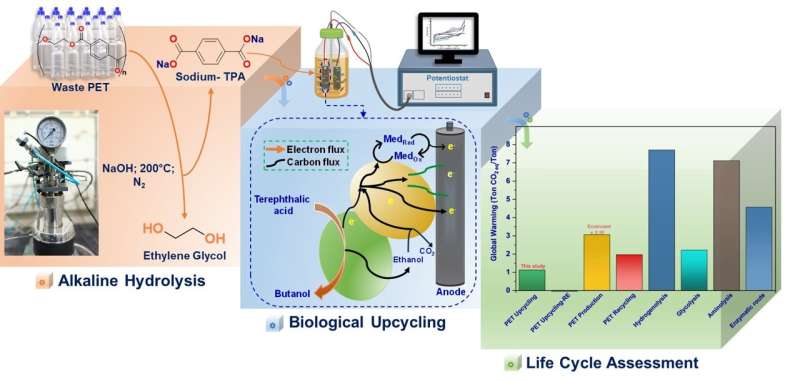In the battle against climate change, the role of chemistry and the chemical industry is often overlooked. As India accelerates its industrial growth, it must embrace sustainable biomanufacturing and green chemistry not just to meet environmental commitments but to reinforce economic competitiveness.
The 21st century has seen plastics revolutionize modern life due to their low cost and versatility. Global plastic production currently stands at approximately 350 million metric tons annually and is projected to triple to 1,200 million metric tons by 2050.
However, most of these plastics are derived from fossil-based ethylene and propylene, which are non-biodegradable. As a result, about 80% of plastic waste ends up in landfills or the natural environment, exacerbating the global pollution crisis, as current recycling systems remain inadequate.
Among plastics, polyethylene terephthalate (PET), widely used in textiles, food packaging and beverage containers, dominates production with more than 65 million metric tons produced annually. Yet only about 15% is recycled, making it a major contributor to landfill waste. Developing sustainable upcycling technologies to convert plastic waste into valuable chemicals is critical for creating a circular plastics economy.
A recent study by Kopperi and colleagues in the field of green chemistry presents a promising solution. The research introduces an innovative, ecofriendly method to convert waste polyethylene terephthalate into biofuel blends, advancing both waste minimization and resource efficiency. This work, published in Green Chemistry, exemplifies how modern chemistry can transform traditional processes into sustainable alternatives, significantly reducing waste, energy use, and toxic emissions.
Why sustainable chemistry matters
Sustainable chemistry is not merely about reducing pollution. It is about designing processes that inherently avoid hazardous substances. Kopperi’s study presented how biobased chemicals can be developed with minimal environmental impact. For a country like India, grappling with rising environmental pressures and an expanding industrial base, such innovation is crucial.
Their method uses an alkali-catalyzed depolymerization of polyethylene terephthalate, followed by microbial conversion in a bioelectrochemical system. This green process improves key environmental metrics and demonstrates a scalable model for sustainable chemical production.
The study also integrates life cycle assessment, embedding sustainability from raw material extraction to product disposal. Essentially, the team demonstrated how bioelectrochemical systems can upcycle terephthalic acid, a polyethylene terephthalate monomer, into high-value biofuels like ethanol and butanol.
By applying a low external electrical potential of +0.8 volts, they enhance microbial metabolic activity and conversion efficiency. Their life cycle assessment results show a significantly lower global warming potential of 1.13 tons of carbon dioxide equivalent per ton of biofuel compared to traditional polyethylene terephthalate recycling methods.
Green chemistry as an economic catalyst
India’s chemical industry is projected to reach $304 billion by 2025 but remains dependent on fossil fuel-based inputs and waste-intensive processes. While the country boasts abundant feedstock for higher carbon compounds like butadiene (C4), benzene (C6), paraxylene (C8) and ortho-xylene (C8), it struggles with shortages in lower carbon chemical precursors (C1–C7), forcing reliance on imports.
Green chemistry and biomanufacturing offer India a strategic opportunity to reduce raw material dependency, cut costs, and unlock new revenue through circular economy models.
Companies investing in sustainable alternatives such as biobased polymers or solvent-free processes stand to benefit from regulatory incentives and growing consumer demand. Multinational corporations like PepsiCo have already demonstrated the value of sustainability by adopting ecofriendly agricultural practices that strengthen supply chains. The same principle applies to chemicals. Businesses integrating green chemistry today will gain a competitive edge tomorrow.
Challenges and way forward
Despite its promise, the adoption of biobased chemicals faces barriers including high upfront costs, limited awareness, and resistance from legacy industries. However, smart policy interventions such as green subsidies, carbon pricing, and mandatory life cycle assessment reporting could accelerate the transition.
India must invest in research and development to scale these emerging technologies and ensure that sustainability aligns with profitability. The study by Kopperi and colleagues makes a strong case that biomanufacturing is not just an environmental imperative but a strategic economic lever. The shift to low-carbon, sustainable chemical manufacturing is no longer optional. It is the cornerstone of India’s industrial future.
This story is part of Science X Dialog, where researchers can report findings from their published research articles. Visit this page for information about Science X Dialog and how to participate.
More information:
Harishankar Kopperi et al, Tandem chemical hydrolysis and bioelectrochemical upcycling of waste polyethylene terephthalate (PET) for sustainable biobutanol and ethanol production ensuring plastics circularity, Green Chemistry (2025). DOI: 10.1039/D4GC04985C
Bio:
First author Dr. Kopperi Harishankar is a Senior Associate at the Center for Study of Science, Technology and Policy (CSTEP) in Bangalore, India. He specializes in Life Cycle Assessment (LCA), Techno-Economic Analysis (TEA), and Sustainable Bioprocess Development. His expertise encompasses waste valorization, low-carbon fuels and chemicals, industrial decarbonization, and circular economy strategies.
Corresponding author Dr. S Venkata Mohan is an Environmental Engineer and currently working as Chief Scientist and Director of CSIR-NEERI, India. His research focuses on green hydrogen, biomanufacturing, low carbon fuels/chemicals, circular and bioeconomy.
Citation:
Sustainable biomanufacturing: Key to India’s green transition (2025, April 1)
retrieved 1 April 2025
from https://phys.org/news/2025-04-sustainable-biomanufacturing-key-india-green.html
This document is subject to copyright. Apart from any fair dealing for the purpose of private study or research, no
part may be reproduced without the written permission. The content is provided for information purposes only.

